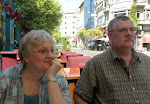.
When walking in Istanbul, one must constantly look in all directions but up.Looking Down: Downward observation will provide you with the necessary road/sidewalk/footpath information you will need to insure safe passage and ample ankle protection. Main roads in Istanbul are asphalt, but side roads are cobblestone, often with a broken-away asphalt covering. Pot holes and uneven surfaces are common. Sidewalks are uneven cobblestone, and frequently feature large unmarked trees growing in the middle of them. Curbs are high, serving as barriers against torrential rainwater, and to discourage sidewalk parking (see below). If you do not look down, you will soon fall down. However, one cannot only look down or one will walk into a tree.
Looking Left and Right: Lateral observation will lengthen your life. In Istanbul, all vehicles, including tricycles, have the right-of-way over pedestrians. Looking both ways will heighten your awareness of approaching vehicles. On busy streets, dodging between cars and buses to get to the other side is the norm. Do not expect cars to stop for you in a crosswalk: crosswalks are like targets and are completely ignored by all vehicles, including tricycles.
Looking Straight Ahead: Full frontal observation will keep you from walking into Istanbullus who instinctually know how to navigate the streets while side-talking to one another or operating a cell phone without bumping into one another. However, since we non-Turks lack this innate ability, they will bump into us, and then look at us as though we are retarded. We be tards not!
Due to the narrowness of the streets, Turks frequently choose to park on the sidewalks, half-on, half-off. This forces pedestrians to walk in the streets, which is not especially dangerous because the drivers expect to see people walking in the streets. (NOTE: I recommend walking in the street—the surface is flatter so one can occasionally glance upward—not recommended for newcomers, however.) Some streets discourage sidewalk parking by placing metal pylons at short intervals along the curb sides. Most are just menacing, black cylinders, but some are ornamental in design and give you something to appreciate while looking down. Full frontal observation will assist you in avoiding these toe stubbers and shin bashers.
Looking Up: This behavior will expose you as a tourist, thus making you vulnerable to hawkers and pick-pockets, as well as to the dangers of not having looked down, left, right or straight ahead. While dangerous, looking up in Istanbul is very enjoyable. There is much to see in this direction since houses, apartments and businesses are conjoined and rise steeply skyward. As in a tropical rain forest, there is much activity in the occupied canopy. (NOTE: When the urge to look up overwhelms you, find a bench and have a sit-look—it’s restful and doesn’t look touristy. Benches are usually available at bus stops.) Frequent sightings: drying laundry; rugs being shaken out; buckets being lowered to other apartments or to the street level where money is replaced with groceries; elderly onlookers; children waving; nesting birds; business advertisements; hair salons on the 9th floor; cafes on roof tops; and everywhere, satellite dishes pointing heavenward, making the buildings look like the rigid, rectangular tentacles of octopi frozen in prayer.
